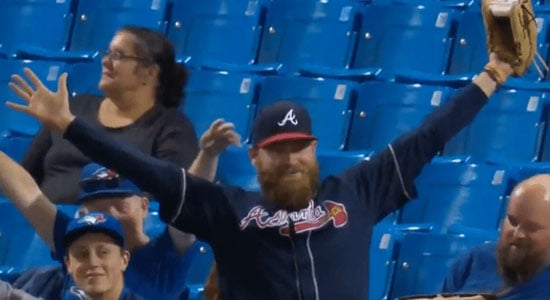Fan interference in baseball has a long history. The rules on it have changed so much, that this piece would be extremely boring if we went through all the changes and intricacies of the existing rules. Instead, let’s look at them through the eyes of two examples seen in one game.
Much of last week’s Toronto Blue Jays versus Atlanta Braves series was overshadowed by the return of slugger Josh Donaldson. It’s easy to forget some of the subtle plays that occurred throughout. Heck, it’s possible you even forgot the young Jays did something they haven’t done a whole lot of this season: split the 2-game series.
That first game was something special. Seeing the new Blue Jays alongside their former superstar Josh Donaldson was exciting to watch on TV. But imagine getting front row tickets to see the game? You would have seen The Bringer of Rain ☔ and re-lived a time Torontonians will never forget while enjoying the nuances of baseball that don’t typically get shown on TV. And hey! Maybe you can catch a foul ball or get one thrown to you by a player. It’s free and you can take it home.
Fan Interference #1
That brings us to one of two overshadowed moments. The first was a foul ball hit off the bat of Braves first baseman Freddie Freeman towards Blue Jays third baseman Vlad Guerrero Jr.
Seconds after the official ruling was made, Guerrero Jr. gave the fan a thumbs up. Moments later, Rogers Centre security escorted the fan from the stands.

Fan Interference #2
The second was a foul ball hit to right field off the bat of Braves third baseman and night’s almighty Josh Donaldson. It was caught by Blue Jays right fielder Bily McKinney, but with an attempt to interfere by a fan.
A bearded man draped in Atlanta Braves gear reached over the barrier to get McKinney to stop the ball. After the play, the fans roared, hollered, pointed to his Braves jersey, and pranced around in joy in front of thousands of Blue Jays home fans. Is this about perception? We’ll admit. There’s nothing worse than seeing an opposing fan in the stands. Especially when said fan might have an actual impact on the outcome of the game.
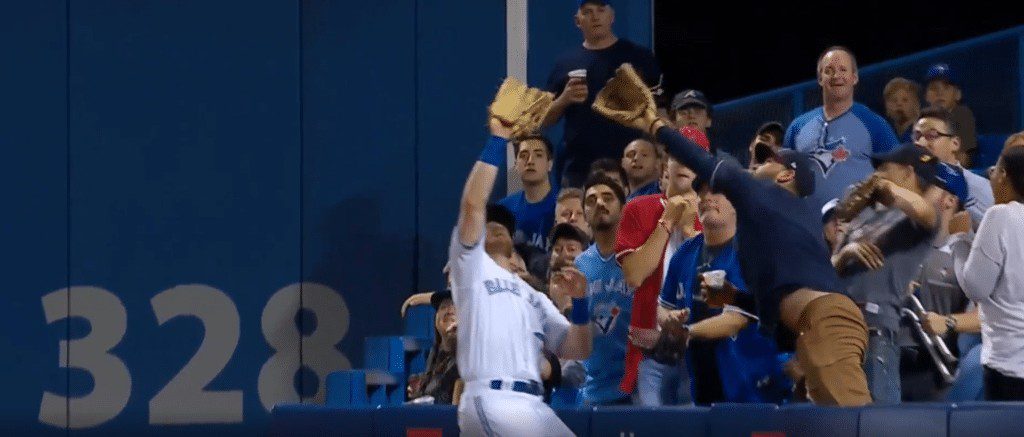
This begs the question: what happens when a fan interferes with a Major League baseball game?
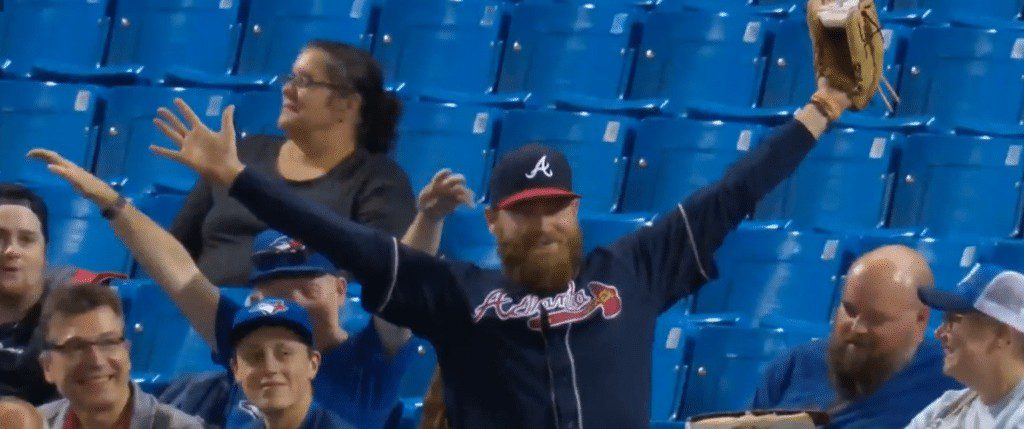
Fairness Issue: Fan Interference
Setting down rules for such volatile things like fan interference has always been an extremely difficult task. There are so many factors and possible outcomes that achieving impartiality within the rules is generally impossible.
For example, how can we decide whether a spectator’s actions had an actual impact on the game?
If a player claims that a sunbeam reflected off a spectator’s watch blinded him during a play, who is to determine the truthfulness of the claim? And let’s say that the player then claims that the blinding caused him to miss a ball. Do we count the point?
If a fan reaches out of the stands to catch a ball, interfering with a player who reached for the same ball, what do we do? It’s situations like these that make it so hard to properly set down rules regulating fan interference, especially in a game like baseball, where fans play a relatively active role in the game.
What is Fan Interference?
Despite the aforementioned difficulties, sports need rules, and baseball is no different. The first step to take is to define what qualifies as fan interference. The official rule is that fan interference occurs when a spectator goes onto the field or reaches over, under or through the barriers and touches a ball in play or a player.
As you might notice, this definition is rather general and lax. In fact, according to it, fan interference can only occur if a fan physically interferes with the game.
What does this mean?
It means that an opposing fan that shouts and mocks players on the field isn’t guilty of interference.
It also means that the previous example of blinding sunlight would also not be considered fan interference.
As you might guess, this causes quite a few issues
Game-Changing Fan Interference
One of the most recognized and important instances of game-changing fan interference is when a fan catches a ball that was still in play, allowing a player to move up multiple bases or even potentially all the way home.
One of the most controversial instances of game-changing fan interference was seen in the eighth inning of Game 6 in the National League Championship Series (NLCS) between the Chicago Cubs and the Florida Marlins. Long-time Cubs fan Steve Bartman (arrow pointed to) reached for the foul ball hit off the Mariners. As a result, he disrupted Cubs outfielder Moises Alou’s attempt to catch. The Cubs went on to lose the game 8 to 3 and eventually the series. Steve Bartman became the subject of death threats and public scrutiny, being blamed for the Cubs perpetual years of not winning a championship.
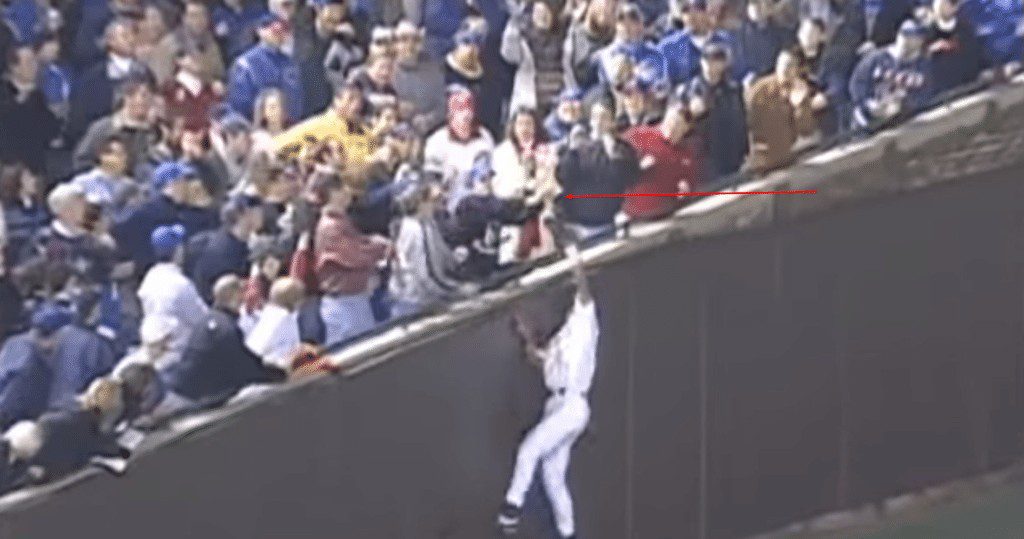
Obviously, this has a huge impact on the game and can determine which team ends up winning the game. In instances like these, the final judgment will for sure be very unpopular with at least one side of the game. And who can blame them?
Fans of the losing team will obviously be angry and blaming the loss on the umpire’s judgment of an instance of fan interference is the most popular thing to do.
Because of this, judgments/verdicts on important fan interference are almost always controversial and highly criticized by fans and media alike.
Fans will accuse umpires of being biased towards a certain team, which is not always false.
Umpires’ Calls On Fan Interference
As stated above, the final verdict rests within the hands of the umpire. This is an immense power: umpires essentially have the ability to decide a point.
They can concede the point to the favoured team (i.e. ignore the fan interference), potentially granting a home run to the team in a situation where, without the fan interference, it would not have been possible.
On the flip side of the coin, they can also nullify a home run, and place the players back to the base where the umpire judges they would have been had the ball not been caught by a fan.
You may have realized that this seems to grant the umpire immense power, and you’re not wrong. The choice of which base to place the players on is entirely up to the umpire, and he does indeed have the final word.
Video Evidence
Since 2008, baseball has begun using video playbacks as a tool to help in various calls. Some of you may argue that video evidence can serve to counteract the umpire’s potential power.
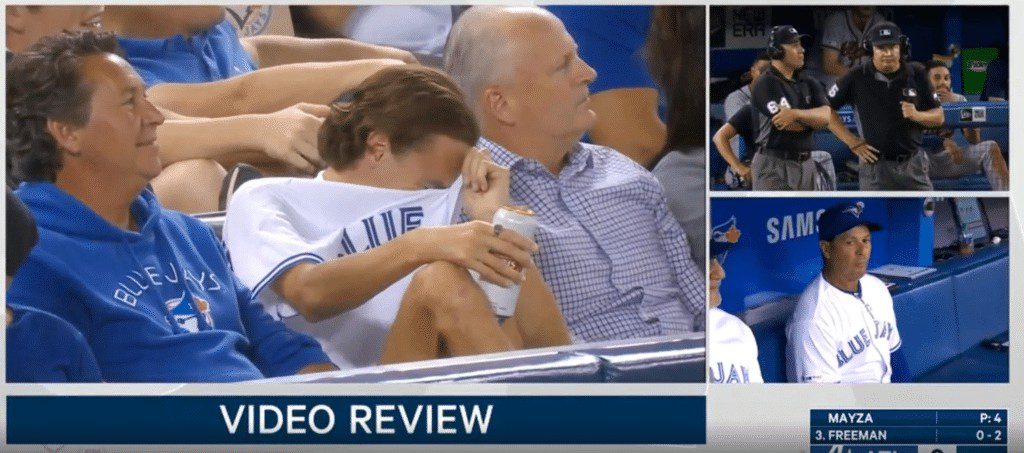
However, you should know that pulling up the video playback of a play is the umpire’s decision too. Even though a player can request the video replay, an umpire can simply refuse to honor the player’s wish. Therefore, should an umpire feel confident in his call, there really is nothing that can overrule it.
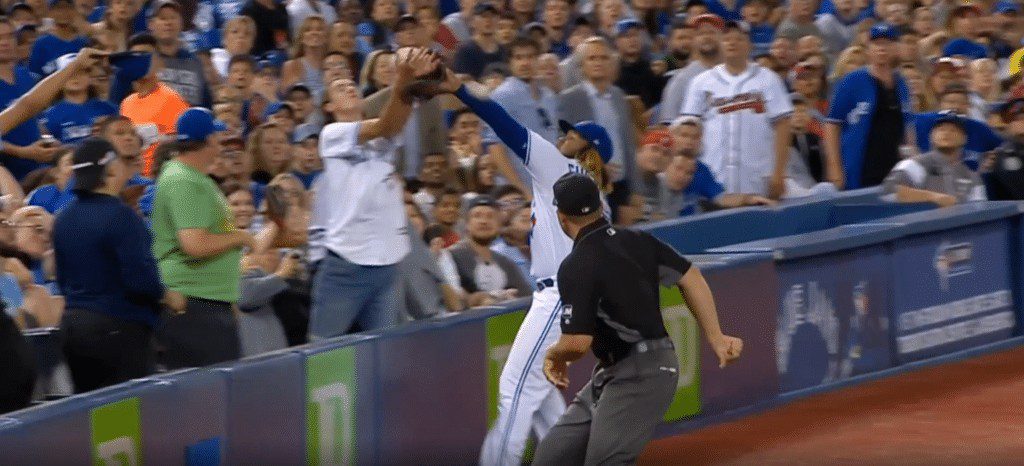
Player-Induced Fan Interference
Whilst a fan reaching out of the stands and touching a ball or player is indeed guilty of fan interference, what happens if a player reaches into the stands? Well, MLB has ruled that spectators who interfere with players reaching into the stands are NOT guilty of fan interference.
This has huge implications: essentially, this means whether a player catches a ball that has been hit into the stands is entirely up to the crowd present.
Often, if the crowd is composed of home fans, they will move back to help their own player catch the ball.
On the flipside, opposing fans will do whatever they can to prevent that same player from saving the ball. This may seem like a rather unfair rule to many of you, but is there really any other way to do things?
After all, it’s not like we can obligate spectators to move away whenever a ball is hit their way. After all, rules are rules. They may not always be fair or impartial, but they are the only things preventing a game from degenerating into total chaos.
Whether we like them or not, we must recognize that rules are a necessary component of every game.

